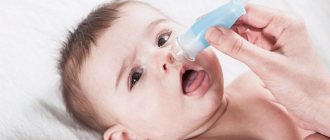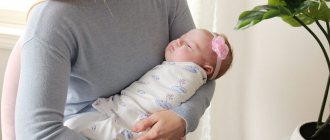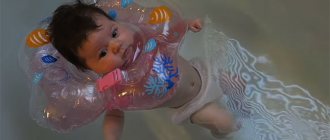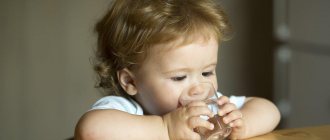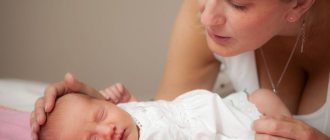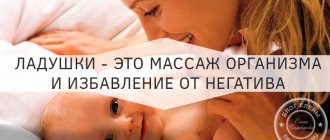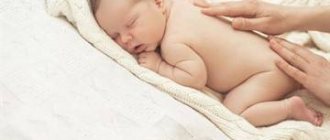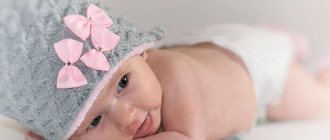The essence of hardening and expected results
The hardening procedure should be accompanied by regular changes of the environment. Natural factors are the best option in this matter. The hardening procedure can be combined with changing the child's clothes, bathing, sleep and gymnastics. There is no need to allocate separate time for this process. All relevant procedures can be harmoniously integrated into the child’s daily routine.
Significant results can be achieved by regular hardening, combining physical exercise. The body’s work is activated and improvement occurs:
- Immunity to diseases;
- Mechanisms of psychological defense and control;
- Work of the circulatory system;
- Metabolism;
- Psycho-emotional state;
- Sleep;
- Appetite.
Effective prevention of colds is constant hardening. The baby will develop more quickly, and will begin to master the skills of walking, speaking, and sitting much earlier than his peers.
Hardening rules
Before you start hardening, you should get the recommendations of doctors. The child must be examined to confirm that there are no contraindications.
Hardening should not be carried out if the baby has:
- Respiratory diseases;
- Heart defect;
- Decreased hemoglobin;
- High temperature;
- Increased nervous excitability;
- Sudden weight loss;
- Impaired gastrointestinal function;
- Restless sleep.
In order for hardening to benefit the child, the following nuances must be taken into account:
- Consistency – regular procedures. No breaks for a couple of days.
- Gradual decrease in temperature - a sudden change in temperature can cause not only psychological stress in the baby, but also the onset of illness.
- Individual characteristics - it is necessary to observe how the baby reacts to the procedure. If there is a pronounced negative reaction, it is best to stop it. To prevent a negative emotional reaction, you should distract the baby with a toy, song, smile or affection.
- The example of parents is the best thing to show the child that mom and dad are also not afraid to resort to hardening. This will not only set an excellent example for your child, but will also help strengthen your own body. Spending time with a child is never superfluous and will make up for a possible lack of attention from parents.
SIMPLE AND USEFUL PROCEDURES
You should choose the moment to start classes together with your pediatrician. Typically, targeted air hardening is recommended to begin at two months, and water rubbing at 3–4 months.
For infants, there are simple methods of gentle hardening. They mean:
| Air hardening | Water hardening |
|
|
Don’t forget about solar treatments, try to walk outside with your baby every day - this is also one of the hardening methods, like sleeping in the fresh air.
From 12–18 months you can start using a contrast shower (a gradual increase in temperature contrast is required).
Hardening methods
The main difference is only in environmental conditions, where there is a change in temperature.
Air hardening
- Walking outside. The optimal temperature is at least 10 degrees. The duration of the first walk is 15 minutes. After a short period, you can double it. As a result, up to a couple of hours every day.
- Air bath. The baby lies naked at room temperature (22 degrees). To begin with, the optimal time is 20-40 seconds with a gradual increase of 30 seconds weekly. This type of hardening can be introduced during a gymnastics complex, during feeding, massage procedures, changing clothes, before and after water procedures.
- Sleeping in nature. It will bring much more benefits, but it is worth dressing the child appropriately.
Water hardening
- The first steps are washing your face. Babies up to three months – 28 degrees, up to six months – 26 degrees, up to one year – 20-24 degrees. The water temperature can be reduced every 2-3 days by 1 degree.
- The next stage is rubbing. It is necessary to start them as soon as the baby turns six months old. A flannel mitten will help in this process; rub it over your arms, back, chest, and stomach until signs of slight redness appear. After 7-10 days, you can start rubbing with a temperature of 35 degrees. In the future, it is necessary to gradually increase the water temperature to 30 degrees.
- The first douche is introduced from the birth of the child and at the end of bathing. Cool water pours onto warm skin. Water temperature – 26 degrees. After the child has been pulled out of the bath, it is necessary to hold him on his arm with his back up. It is necessary to pour from the heels, moving from the spine to the back of the head. The water temperature drops by one degree every five days. The lower limit is considered to be 18 degrees.
- Baby swimming. It is a familiar way of movement for him, since for nine months the baby was regularly in amniotic fluid. Until the first trimester, the baby retains the ability to swim, which will ensure free movement. After six months, you should try swimming in a pool.
Hardening with light
Sunbathing is vital for a child. Only during exposure to light does his body produce vitamin D, which is vital for bone growth. The duration and heating of sunbathing are similar to air baths. The only thing is that you should not place your child in direct sunlight.
Hardening and the age of the child
Every mother is interested in the question of what needs to be done to ensure that the baby grows healthy and active, and whether the method of early hardening will harm the baby. In fact, many parents’ fears are unfounded; proper hardening will strengthen the immune system and help avoid frequent illnesses.
For children under one year old, air hardening is ideal, which can be carried out while changing the child's clothes. Then include dousing with cool water or using wet wipes in your daily bathing. Don’t forget about walks, you should choose the right clothes for your baby.
For children over 3 years of age, in addition to the above, you can use contrast procedures and begin using sun hardening. Good results at this age are achieved by combining and changing hardening methods. Hardening of children and adolescents can include a full range of immune-strengthening activities.
Contrasting and intensive hardening methods
It is necessary to consider how well the child has adapted. These methods are based on: dousing with cold water, immersing in an ice hole, walking in the snow. If there are chronic diseases, there is no need to subject the child to intensive hardening.
The contrast method involves a quick and sudden change in temperature. It includes:
- Rubbing;
- Taking a shower;
- Foot baths;
- Sauna and bathhouse.
The difference in temperature during the first contrast-type procedure is within 4 degrees (from 40 to 36 degrees). After five days, the lower limit can be lowered by one unit and stop at 23-26 degrees. Alternating water is possible 5-6 times during the entire process with an interval of 20 seconds. Finally, water at a warmer temperature is turned on.
The hardening procedure in infancy does not consist of only air baths and pouring water. Movement, harmonious nutrition, an optimal daily routine, daily exercise, being in the fresh air, a hardening procedure - a recipe thanks to which a child will grow up to be a truly harmoniously developed personality.
Where to start hardening a child
You need to start hardening by changing the lifestyle of the whole family. After all, the strengthening of the protective functions of the immune system will not occur when dousing with cold water. To effectively strengthen a child’s health, hardening procedures should include other simple activities.
To do this, it is enough to bring the baby’s lifestyle closer to the natural.
- Regular walks
The child should be outside every day and play actively in the fresh air. This significantly strengthens the baby's immunity. When choosing between a walk and watching TV, parents should give preference to spending time together outside.
- Don't mess around!
Pay attention to how many layers of clothing your child is wearing. Dr. Komarovsky says that at temperatures above 23 degrees, one thin layer of clothing, a dress or a sleeveless T-shirt is sufficient.
The child is constantly on the move and freezes much less often than the parents. Dressed warmly, in several layers, babies quickly sweat, which causes the development of diseases.
Doctors recommend gradually accustoming the baby to light clothing and allowing him to run around the house barefoot. This stimulates the reflex zones that are located on the foot and perfectly strengthens the child’s immunity.
- Weather in the house
One of the causes of frequent colds is considered to be too dry indoor air.
Overdried mucous membranes lose their protective properties and cease to resist viruses and bacteria. This is especially true for rooms with additional heaters and heated floors. In houses where heated floors are constantly running, air humidity drops to 20%, with normal levels being 40-60%.
If the air in your apartment is too dry, you should think about methods of additional humidification.
The temperature in the room should be 20-22 degrees. Maintaining sufficient humidity and temperature conditions in the house will protect the baby from many problems.
- Daily regime
The correct balance of exercise, walks in the fresh air and rest forms the basis of the baby’s health. It is important to prevent the baby from being overloaded with too many sections and increased psycho-emotional stress.
- Proper nutrition
A healthy diet consists of sufficient intake of nutrients from food that are involved in the formation of the body’s defense against infections. It is undesirable to eat heavy food, overeat and force-feed the child. You need to follow a feeding schedule and eat simple and healthy food.
- Hardening procedures
The rational use of hardening procedures has a positive effect on the baby’s body, improving blood circulation, metabolism, and the functioning of the nervous system. The child gradually adapts to the effects of hardening factors, and the ability to resist infections increases.
Hardening procedures are divided depending on the environmental factor that affects the body. The most common and effective systems for hardening children are water and air procedures, and sun hardening.
